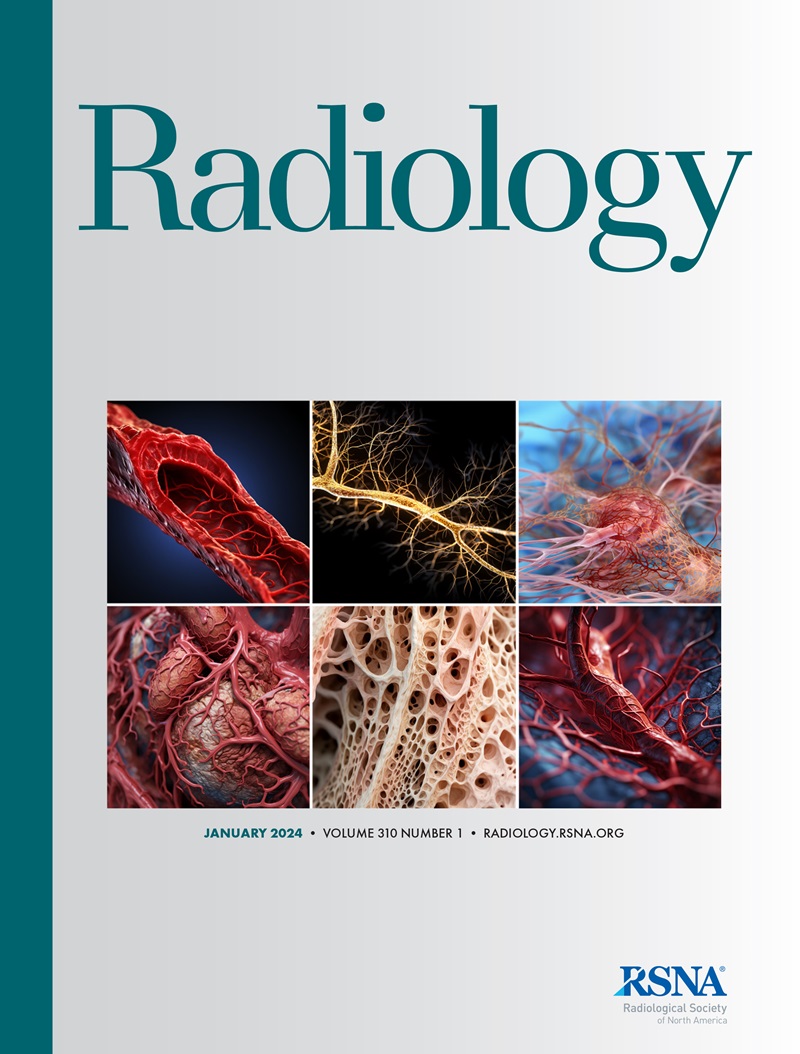Disparities in Standard-of-Care, Advanced, and Same-Day Diagnostic Services among Patients with Abnormal Screening Mammography.
Marissa B Lawson, Weiwei Zhu, Diana L Miglioretti, Tracy Onega, Louise M Henderson, Garth H Rauscher, Karla Kerlikowske, Brian L Sprague, Erin J A Bowles, Ellen S O'Meara, Anna N A Tosteson, Roberta M diFlorio-Alexander, Rebecca A Hubbard, Janie M Lee, Christoph I Lee
求助PDF
{"title":"Disparities in Standard-of-Care, Advanced, and Same-Day Diagnostic Services among Patients with Abnormal Screening Mammography.","authors":"Marissa B Lawson, Weiwei Zhu, Diana L Miglioretti, Tracy Onega, Louise M Henderson, Garth H Rauscher, Karla Kerlikowske, Brian L Sprague, Erin J A Bowles, Ellen S O'Meara, Anna N A Tosteson, Roberta M diFlorio-Alexander, Rebecca A Hubbard, Janie M Lee, Christoph I Lee","doi":"10.1148/radiol.241673","DOIUrl":null,"url":null,"abstract":"<p><p>Background Diagnostic imaging and biopsy are used to evaluate abnormal screening mammography. Differences in on-site availability and receipt of these diagnostic services may contribute to disparities in breast cancer outcomes across sociodemographic groups. Purpose To identify multilevel factors associated with on-site availability and receipt of diagnostic imaging and biopsy after screening mammography. Materials and Methods This retrospective study included female patients (age range, 40-89 years) who underwent screening mammography at 136 facilities in the United States from January 2010 to December 2020. The primary exposure variables were race and ethnicity and neighborhood-level educational attainment, household income, and rurality. The adjustment variables were age, breast density, breast biopsy history, personal and family history of breast cancer, time from prior mammographic examination to screening mammography, screening modality, facility academic affiliation, and screening examination year. The relative risk (RR) of factors for on-site availability at screening facilities and undergoing standard-of-care imaging (ie, mammography and/or US) and advanced diagnostic imaging (ie, digital breast tomosynthesis, MRI) and biopsy, and undergoing any same-day diagnostic service and biopsy were estimated using modified Poisson regression. Results In total, 1 123 177 female patients (median age, 59 years; IQR, 51-67 years) underwent 3 519 502 screening mammographic examinations: 10.3% Asian patients (362 440 of 3 519 502), 12.7% Black patients (447 777 of 3 519 502), 6.5% Hispanic patients (227 177 of 3 519 502), 68.3% White patients (2 403 159 of 3 519 502), and 2.2% all other races and ethnicities (78 949 of 3 519 502). In most fully adjusted models, race or ethnicity and neighborhood-level socioeconomic status were not associated with on-site diagnostic service availability. However, compared with White patients, patients belonging to racial and ethnic minority groups were less likely to undergo same-day diagnostic services after abnormal screening mammography (Asian patients: RR, 0.74 [95% CI: 0.64, 0.85]; Black patients: RR, 0.56 [95% CI: 0.49, 0.63]; Hispanic patients: RR, 0.61 [95% CI: 0.52, 0.71]). Black patients were less likely to undergo same-day biopsies after an abnormal diagnostic workup (RR, 0.46; 95% CI: 0.33, 0.65). Conclusion Although no evidence existed that on-site diagnostic service availability varied by race and ethnicity in most models, patients in racial and ethnic minority groups were less likely to be provided same-day diagnostic services and Black patients were less likely to undergo same-day biopsy. © RSNA, 2025 <i>Supplemental material is available for this article.</i> See also the editorial by Mullen in this issue.</p>","PeriodicalId":20896,"journal":{"name":"Radiology","volume":"314 2","pages":"e241673"},"PeriodicalIF":12.1000,"publicationDate":"2025-02-01","publicationTypes":"Journal Article","fieldsOfStudy":null,"isOpenAccess":false,"openAccessPdf":"","citationCount":"0","resultStr":null,"platform":"Semanticscholar","paperid":null,"PeriodicalName":"Radiology","FirstCategoryId":"3","ListUrlMain":"https://doi.org/10.1148/radiol.241673","RegionNum":1,"RegionCategory":"医学","ArticlePicture":[],"TitleCN":null,"AbstractTextCN":null,"PMCID":null,"EPubDate":"","PubModel":"","JCR":"Q1","JCRName":"RADIOLOGY, NUCLEAR MEDICINE & MEDICAL IMAGING","Score":null,"Total":0}
引用次数: 0
引用
批量引用
Abstract
Background Diagnostic imaging and biopsy are used to evaluate abnormal screening mammography. Differences in on-site availability and receipt of these diagnostic services may contribute to disparities in breast cancer outcomes across sociodemographic groups. Purpose To identify multilevel factors associated with on-site availability and receipt of diagnostic imaging and biopsy after screening mammography. Materials and Methods This retrospective study included female patients (age range, 40-89 years) who underwent screening mammography at 136 facilities in the United States from January 2010 to December 2020. The primary exposure variables were race and ethnicity and neighborhood-level educational attainment, household income, and rurality. The adjustment variables were age, breast density, breast biopsy history, personal and family history of breast cancer, time from prior mammographic examination to screening mammography, screening modality, facility academic affiliation, and screening examination year. The relative risk (RR) of factors for on-site availability at screening facilities and undergoing standard-of-care imaging (ie, mammography and/or US) and advanced diagnostic imaging (ie, digital breast tomosynthesis, MRI) and biopsy, and undergoing any same-day diagnostic service and biopsy were estimated using modified Poisson regression. Results In total, 1 123 177 female patients (median age, 59 years; IQR, 51-67 years) underwent 3 519 502 screening mammographic examinations: 10.3% Asian patients (362 440 of 3 519 502), 12.7% Black patients (447 777 of 3 519 502), 6.5% Hispanic patients (227 177 of 3 519 502), 68.3% White patients (2 403 159 of 3 519 502), and 2.2% all other races and ethnicities (78 949 of 3 519 502). In most fully adjusted models, race or ethnicity and neighborhood-level socioeconomic status were not associated with on-site diagnostic service availability. However, compared with White patients, patients belonging to racial and ethnic minority groups were less likely to undergo same-day diagnostic services after abnormal screening mammography (Asian patients: RR, 0.74 [95% CI: 0.64, 0.85]; Black patients: RR, 0.56 [95% CI: 0.49, 0.63]; Hispanic patients: RR, 0.61 [95% CI: 0.52, 0.71]). Black patients were less likely to undergo same-day biopsies after an abnormal diagnostic workup (RR, 0.46; 95% CI: 0.33, 0.65). Conclusion Although no evidence existed that on-site diagnostic service availability varied by race and ethnicity in most models, patients in racial and ethnic minority groups were less likely to be provided same-day diagnostic services and Black patients were less likely to undergo same-day biopsy. © RSNA, 2025 Supplemental material is available for this article. See also the editorial by Mullen in this issue.


